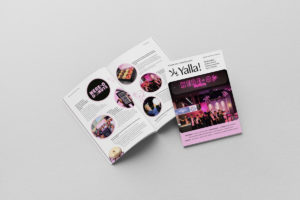4 mins reading time
“It doesn’t talk back. It doesn’t beep or update or invite a click. It doesn’t change based on who’s consuming it. It doesn’t interrupt you, and it begs to not be interrupted. It’s rarer than ever before, and sometimes, we need it.”
Seth Godin
This was the daily blog update from Seth Godin waiting in our Inbox on 6th February. And we completely agree.
For years, at least in our industry, there have been design agencies writing about Print vs Digital Media as though it were a raging battle to the death. Print being the traditional and established medium, facing an uphill battle for survival against the inevitable march of progress.
It’s not just the creative agencies either. The Print industry itself seems to love this subject. Search online and you’ll find dozens of posts from print companies, all discussing their doomsday extinction event and posing the same question: “Is Print Dead?” Of course, they all reach the same cheery conclusion in the end: “Print is most definitely not dead!” Despite the hype, there is an important point here. Digital media is brilliant. We can organise huge volumes of information. And we can easily interact with a website or app to filter only that nugget of information that we’re looking for. Using Google beats using a Yellow Pages phone directory. When it makes perfect sense, of course Digital media is going to replace Print. But the reverse is equally true. There is often no substitute for print and physical media. In fact, some things demand it.
You sometimes need a non-interactive way of conveying crucial information. The patient information leaflet inside your medicine box. The emergency procedure instructions in your aircraft seat pocket. The ingredients, allergens, and nutritional information on your cereal box. These are instances where interactive media just won’t do. Communicating the all-important USP that sets your company apart from competitors is another. You want to make sure people get the full facts verbatim. No shortcuts, no filtering, no options. Just the complete unabridged version.
Interactive digital media makes sense when offering choice is beneficial. Non-interactive media is the clear winner when presenting an audience with choice is undesirable.
The competition for attention is different too. Media that interrupts is prone to being interrupted. You might be prompting prospects to interact with online ads, notifications, or emails. But so is everybody else. Some have referred to the mobile phone screen as the most valuable real estate in the world. And the competition for that space is the problem. Your content is either on-screen in that moment or it’s gone. Out of sight and out of mind. Use a digital medium and you’re competing with hundreds of other interruptions; messages, calls, alarms, social media updates. It takes one notification to steal away your viewer’s attention.
The same is true of printed media. Phones continue to ring, beep and buzz. But when they stop, the print material remains. This makes a huge difference. As a physical item, print communications can wait unobtrusively in the background until the reader is ready. It’s a less aggressive and more respectful approach, but also more enduring and persistent. A physical medium like a brochure is ever-present, it can be in the right place at the right time, even if that’s months or years after it was first presented.
It also asks less of the recipient. Interactive media demands input from the user, they have to choose to open up your content. Whether it’s opening an email, opening a file, or visiting your website, interactive media makes you very reliant on the recipient being motivated enough to take action. If there isn’t any intent, your content isn’t being called up on-screen. Physical communications don’t r equire that commitment from the reader. They are ready to browse, without any clicking, typing, or navigation being needed to call them into existence. Once your material is in the right hands, your communication goals are so much nearer.
Comprehension is very much part of the digital vs print debate too. Numerous studies suggest that reading printed texts results in better speed, accuracy, and comprehension over digital texts. This matters even more so in the Arabian Gulf, where English is a foreign language to most people. Print provides a solid marketing foundation. And we boost that effectiveness further with localisation, when we translate and design bilingual English/Arabic communications.
These qualities help make our work especially impactful. When a client goes to the trouble of attending an event, we want everybody they interact with to leave with outstanding print communications in hand; designed to capture and hold their interest, with messaging that’s clear and engaging, and comprehensive content that’s understood by all – in English and Arabic. Paired with exceptional printing, it should be too good to misplace or discard, a powerful communication tool that’s going nowhere fast.



